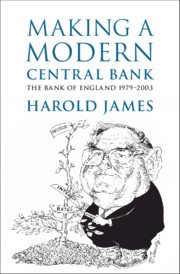Book contents
- Making a Modern Central Bank
- Studies in Macroeconomic History
- Making a Modern Central Bank
- Copyright page
- Dedication
- Contents
- Figures
- Tables
- Acknowledgements
- Abbreviations
- 1 Introductory
- 2 Foreign Fetters
- 3 The Performance of the UK Economy
- 4 The Inexplicable in Pursuit of the Uncontrollable
- 5 ‘A Good Deal of Advice’
- 6 The Long Shadow of the Deutschemark
- 7 Hong Kong
- 8 Shaved Eyebrows
- 9 Tunnelling Deep
- 10 Great Leap in the Dark
- 11 The Spine Theory and Its Collapse
- 12 ‘You Can’t Be In and Out at the Same Time’:
- 13 Horses for Courses
- 14 Failure of Internal Communication
- 15 The New Bank
- 16 Epilogue
- Book part
- Notes
- Bibliography
- Index
13 - Horses for Courses
The Drive for Independence
Published online by Cambridge University Press: 18 September 2020
- Making a Modern Central Bank
- Studies in Macroeconomic History
- Making a Modern Central Bank
- Copyright page
- Dedication
- Contents
- Figures
- Tables
- Acknowledgements
- Abbreviations
- 1 Introductory
- 2 Foreign Fetters
- 3 The Performance of the UK Economy
- 4 The Inexplicable in Pursuit of the Uncontrollable
- 5 ‘A Good Deal of Advice’
- 6 The Long Shadow of the Deutschemark
- 7 Hong Kong
- 8 Shaved Eyebrows
- 9 Tunnelling Deep
- 10 Great Leap in the Dark
- 11 The Spine Theory and Its Collapse
- 12 ‘You Can’t Be In and Out at the Same Time’:
- 13 Horses for Courses
- 14 Failure of Internal Communication
- 15 The New Bank
- 16 Epilogue
- Book part
- Notes
- Bibliography
- Index
Summary
After September 1992, the Bank was at the forefront of the search for a new policy framework. It pushed the idea of central bank independence, that was heavily supported by academic theory, as well as by the framework established in 1991 at the Treaty of Maastricht. The reform was driven by the new Governor, Eddie George, but also by Chief Economist Mervyn King. The Bank also defined its mission in terms of three core purposes, monetary stability, financial stability, but also the promotion of the efficiency and effectiveness of the UK financial services sector; and reformed its administrative organization – a move that was highly unpopular with its staff. The key to the new policy was an inflation target, established by the government, and implemented through regular meetings of the Chancellor of the Exchequer (at that time Kenneth Clarke) and the Governor of the Bank. These attracted considerable publicity, and were known as the Ken and Eddie show: it was often thought to be an exercise in which a hawkish Governor pressed for interest rate rises, which a doveish and politically sensitive Chancellor resisted.
Keywords
- Type
- Chapter
- Information
- Making a Modern Central BankThe Bank of England 1979–2003, pp. 318 - 375Publisher: Cambridge University PressPrint publication year: 2020

